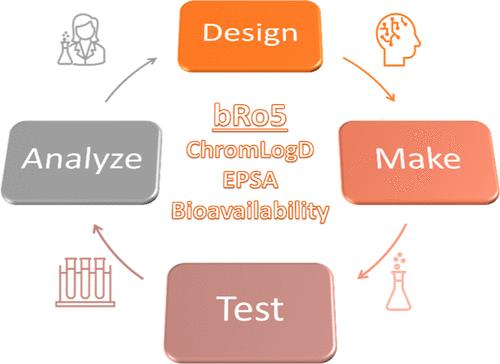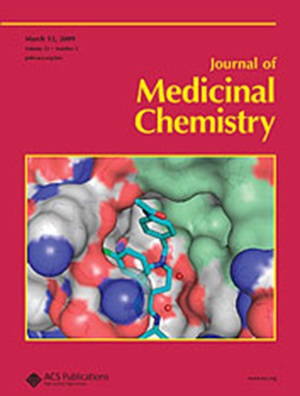Closing the Design–Make–Test–Analyze Loop: Interplay between Experiments and Predictions Drives PROTACs Bioavailability
IF 6.8
1区 医学
Q1 CHEMISTRY, MEDICINAL
引用次数: 0
Abstract
The drug development landscape is expanding to include drug modalities such as PROteolysis-TArgeting Chimeras (PROTACs) and peptides, offering possibilities for previously intractable biological targets. However, with their size and chemical nature, they diverge from established frameworks for the prediction of oral bioavailability. This evolution to larger and more complex molecules necessitates new methodologies and prediction models to continuously expand on bioavailability guidelines. We describe the high-capacity adoption of two chromatographic physicochemical assays and their application for iterative compound optimization to achieve oral bioavailability. We further describe how these data underpin the continuous refinement of internal machine learning models, which guide compound synthesis decisions in the molecular design phase. Based on data for a set of 691 PROTACs, and two project examples, we confirm a sweet spot for oral bioavailability at log D values higher than the norm for small molecules and show how experimental data and prediction models synergize to effectively drive chemistry optimization.

关闭 "设计-制造-测试-分析 "循环:实验与预测的相互作用推动了 PROTACs 生物利用率的提高
药物开发领域正在不断扩大,包括PROteolysis-TArgeting Chimeras (PROTACs) 和肽等药物模式,为以前难以解决的生物靶点提供了可能性。然而,由于它们的大小和化学性质,它们与预测口服生物利用度的既定框架存在差异。这种向更大、更复杂分子的演变需要新的方法和预测模型来不断扩展生物利用度指南。我们介绍了两种色谱理化测定的大容量采用及其在化合物迭代优化中的应用,以实现口服生物利用度。我们进一步介绍了这些数据如何支持内部机器学习模型的不断完善,这些模型可在分子设计阶段指导化合物合成决策。基于一组 691 个 PROTAC 的数据和两个项目实例,我们确认了口服生物利用度的甜蜜点,即对数 D 值高于小分子的标准值,并展示了实验数据和预测模型如何协同作用,有效推动化学优化。
本文章由计算机程序翻译,如有差异,请以英文原文为准。
求助全文
约1分钟内获得全文
求助全文
来源期刊

Journal of Medicinal Chemistry
医学-医药化学
CiteScore
4.00
自引率
11.00%
发文量
804
审稿时长
1.9 months
期刊介绍:
The Journal of Medicinal Chemistry is a prestigious biweekly peer-reviewed publication that focuses on the multifaceted field of medicinal chemistry. Since its inception in 1959 as the Journal of Medicinal and Pharmaceutical Chemistry, it has evolved to become a cornerstone in the dissemination of research findings related to the design, synthesis, and development of therapeutic agents.
The Journal of Medicinal Chemistry is recognized for its significant impact in the scientific community, as evidenced by its 2022 impact factor of 7.3. This metric reflects the journal's influence and the importance of its content in shaping the future of drug discovery and development. The journal serves as a vital resource for chemists, pharmacologists, and other researchers interested in the molecular mechanisms of drug action and the optimization of therapeutic compounds.
 求助内容:
求助内容: 应助结果提醒方式:
应助结果提醒方式:


